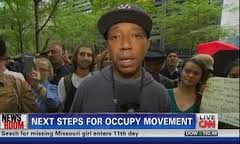Journalists Reflect on Challenge of Covering Social Protests

–Guest post by Jan Lauren Boyles, American University doctoral student.
With looming austerity measures that would triple the cost of UK tuition hanging in the balance, Jon Offredo joined the throng of student protesters in London. Then a 23-year-old journalism graduate student at Newcastle University, he described the day he encountered one year ago as simply “terrifying.”And that was before he even left his flat.”The minute I woke up, checked Twitter, Facebook and various blogs – I could feel the animosity and anger amongst students,” he said.
Within hours, Offredo would experience those emotions firsthand.”I distinctly remember one student being carried back by other protesters,” Offredo said. “This student was battered and absolutely bloodied. He had several head injuries and was bleeding profusely. I’m not scared easily, but when the mounted officers made the decision to charge through the lines – I stopped in my tracks.”
Yet after that momentary pause, Offredo kept following the phalanx of protesters to Westminster Bridge — all the while dodging bottles and firecrackers intended for the police. Driven by the innate trait of journalistic curiosity, he wanted to record the action himself. “That day was extremely challenging as a reporter,” Offredo said. “I started filming some of it, but then even I had to stop and run. I wasn’t sure what was going to happen next. All I remember is thinking of that student and wondering if I was next to be carried back.”
Offredo’s adrenaline rush is mirrored by thousands of reporters who enter riot zones every day. Mass uprisings involving violence, like the London student protests, are socialized into the very core of journalists as newsworthy events, researchers Douglas McLeod and James Hertog contend. In a seminal study examining how the media frame protest movements, the duo argued that the media’s treatment of the protesters is integral to whether the movement gains traction or dies prematurely.
In this light, the journalism community has been both lauded and lamented in various circles for its reporting of the Occupy Wall Street movement. Depictions of the diverse culture amassed in Lower Manhattan has been transmitted nationwide by the media.
Another young journalist, Benjamin Hancock, has been logging numerous hours interviewing the protesters. In his reporting, the Columbia University School of Journalism graduate student says he makes concerted efforts to ensure his stories are representative of the larger crowd. “It’s fascinating to see all the nut jobs that mask and undermine the actual movement [in the media],” Hancock said. He hopes his pieces provide a counterpoint to that narrative.
McLeod and Hertog argue that mainstream coverage often focuses upon deviance. Despite this fact, both Hancock and Offredo both espouse the long-standing journalistic notion of objectivity — attempting to strike balance between dichotomous forces. Such movements need a “critical and objective viewpoint,” Offredo says, which only the media can provide. “No one in these movements wants to be mythologized,” he adds.
Offredo and Hancock exemplify a new trend in journalistic practice — journalists on standby pitching stories as ad hoc freelancers. Although both young men possess journalism degrees, they did not take press passes into the protest zone. Yet both ultimately produced stories for the mainstream press.
In discussing the emergent media ecologies that define the landscape, British scholar Simon Cottle suggests that the Internet can “unsettle and on occasion disrupt” the flow of messages from social activists. Citizen media adds another complicating factor into the mix.
“There’s nothing stopping me from going out and doing what I love to do,” Offredo said. “I don’t need an official attachment to go out and talk to people. I’m not going to sit around and wait for someone to call and ask me to do a story. I’ll go out and do it myself, and then call someone when I have something of quality to show them.”
Offredo’s stories were ultimately published in his home state of Pennsylvania by the Pittsburgh Post-Gazette. Hancock’s work has been appearing in numerous publications all over the Web, where he not only blogs — but Facebooks and Tweets as well. (And yes, Hancock insists those verbs are completely acceptable in today’s parlance).”Technology has made reporting open to the every man,” Hancock says. “There is no ivory tower guarding the journalists.”No longer hiding in established newsrooms, everyday reporters are on the front lines of social activism.
–Guest post by Jan Lauren Boyles, a doctoral student at American University’s School of Communication. She currently serves as project manager at AU’s Center for Social Media. Before joining American, Boyles served for five years as a faculty member and Director of Advising at West Virginia University’s P.I. Reed School of Journalism. She is also a former newspaper reporter for the Charleston Daily Mail.
Read other posts by AU doctoral students and find out more about the doctoral program in Communication at American University.
References:
McLeod, D. M., & Hertog, J. K. (1992). The Manufacture ofPublic Opinion’by Reporters: Informal Cues for Public Perceptions of Protest Groups. Discourse & Society, 3(3), 259. [PDF]
Cottle, S. (2008). Reporting demonstrations: The changing media politics of dissent. Media, Culture & Society, 30(6), 853.





